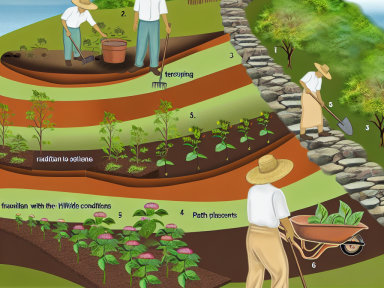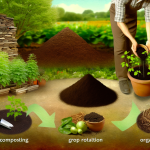Terracing: Building the Foundation
Terracing is one of the oldest and most effective methods for gardening on slopes. By creating a series of level steps or “terraces” in the hillside, you can prevent soil erosion and water runoff while maximizing your planting area.
Steps to Create Terraces
- Assess the Slope: Determine the gradient of your slope to decide the number and height of your terraces.
- Measure and Mark: Use stakes and string to outline where each terrace will be. It helps to have a clear, level reference line.
- Excavate: Dig into the hillside to create flat, level steps. Use the displaced soil to build up a retaining wall on the front edge of each terrace.
- Stabilize: Add retaining materials such as stones, logs, or bricks to hold the soil in place.
- Refill and Plant: Backfill each terrace with soil and compost before planting your garden.
Contour Farming: Working with Nature
Contour farming involves planting crops along the natural contours of the slope. This method can be less labor-intensive than terracing and can still significantly reduce soil erosion.
Steps to Implement Contour Farming
- Map the Contours: Use a water level or laser level to map the natural contours of your slope. Mark these lines with stakes.
- Create Contour Lines: Till or create raised beds along these lines, following the natural curve of the land.
- Plant in Rows: Plant your crops in rows along the contour lines. This will help capture water and allow it to percolate into the soil.
Swales: Harnessing Water
Swales are shallow, water-harvesting ditches dug along the contour lines. They help to slow down water runoff, capture rainwater, and direct it to your plants’ root zones.
Steps to Create Swales
- Identify Contour Lines: Similar to contour farming, use a level to find and mark the contour lines on your slope.
- Dig Trenches: Dig shallow ditches, or swales, along these lines. Make sure they are level to effectively capture and hold water.
- Mound Up Soil: Use the soil you’ve dug out to create a berm on the downhill side of each swale.
- Plant in Swales: Plant water-loving plants inside the swales and less thirsty plants along the berms.
Using Ground Covers: Natural Erosion Control
Planting ground covers can help stabilize the soil on your slope, reducing erosion and retaining moisture. Choose plants that are native to your area for the best results.
Recommended Ground Covers
- Creeping Thyme: Low-growing, hardy, and fragrant, it provides excellent coverage.
- Periwinkle (Vinca minor): Known for its rapid growth and ability to cover large areas quickly.
- Rockrose (Cistus): Ideal for dry slopes, rockrose is drought-tolerant and has a spreading habit.
- Ornamental Grasses: Plant clumps of drought-tolerant grasses like blue fescue or feather reed grass.
Gabions: Practical and Aesthetic Retention Walls
Gabions are wire cages filled with stones or other materials, used to build retaining walls. They provide excellent soil stabilization and can be a visually appealing feature in your garden.
Steps to Build Gabions
- Plan Your Layout: Determine where you need the retaining structures based on the slope gradient.
- Assemble Gabion Cages: Purchase or build wire cages and assemble them as per manufacturer instructions.
- Fill with Stones: Fill the cages with stones, brick, or concrete. Ensure the material is packed tightly.
- Anchor the Cages: Secure the gabions in place using stakes or by connecting multiple cages together.
- Backfill and Plant: Once your gabion wall is stable, backfill with soil and plant as desired.
Employing these historic methods for gardening on slopes will not only enhance the functionality of your inclined garden but also ensure its long-term sustainability. Happy gardening!




GIPHY App Key not set. Please check settings